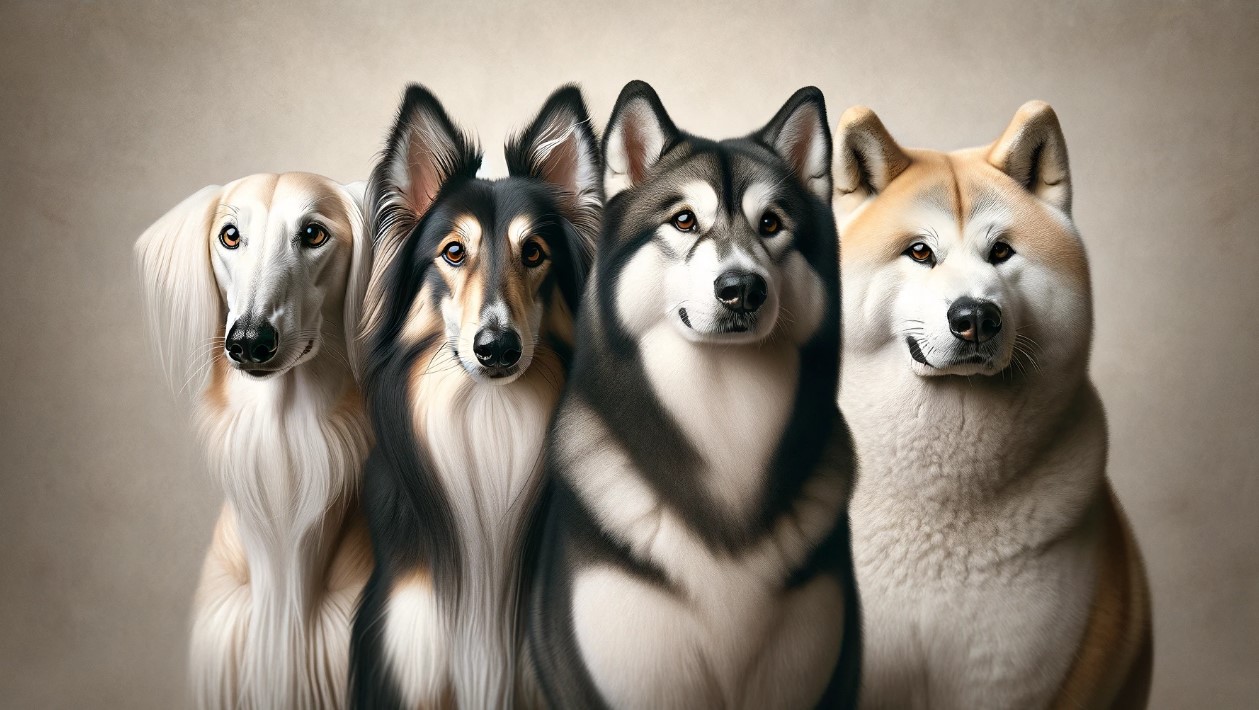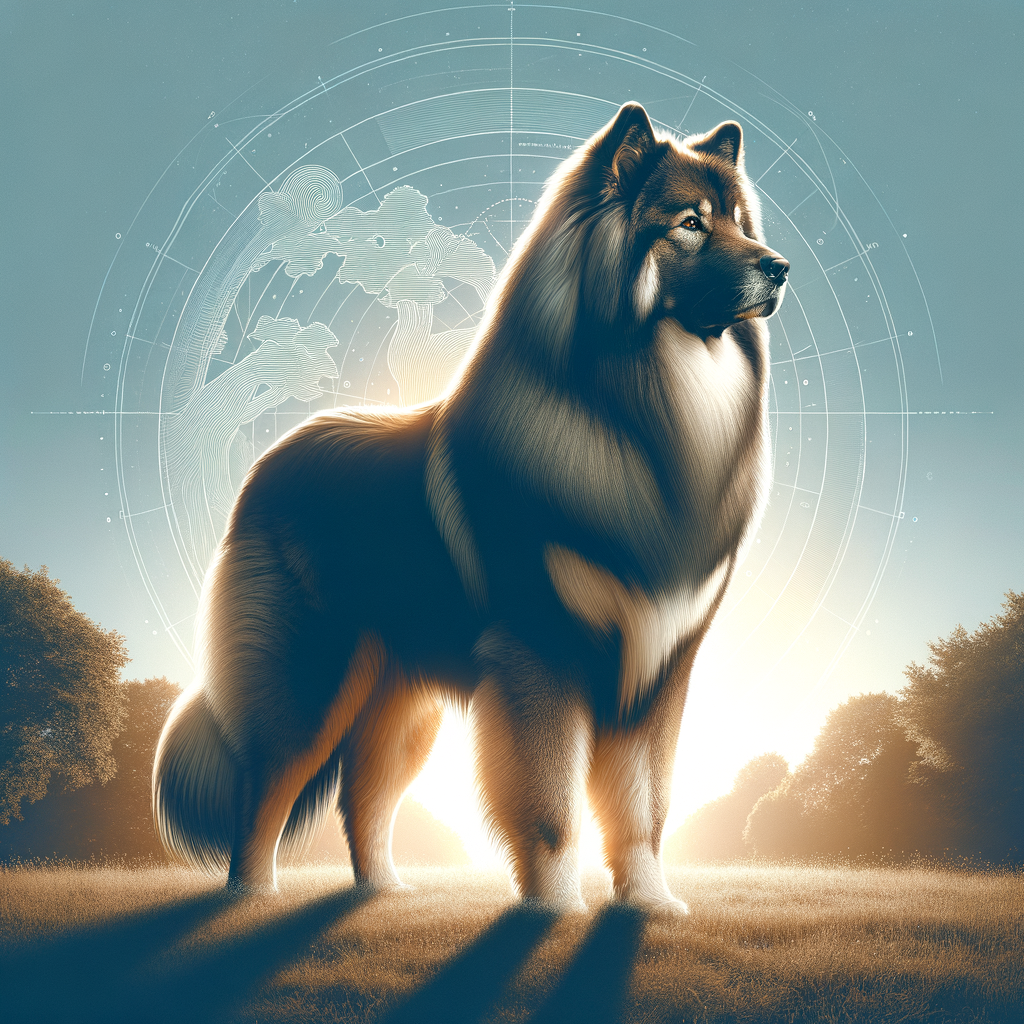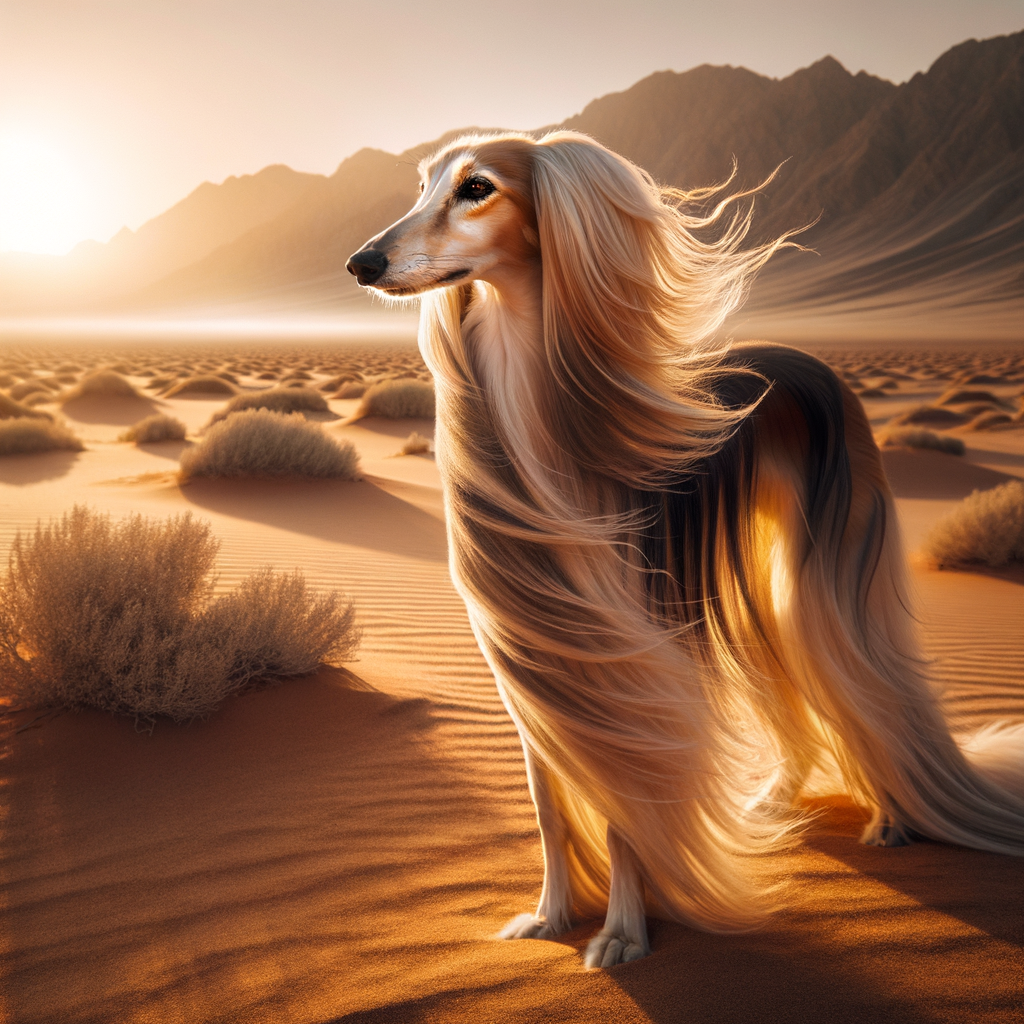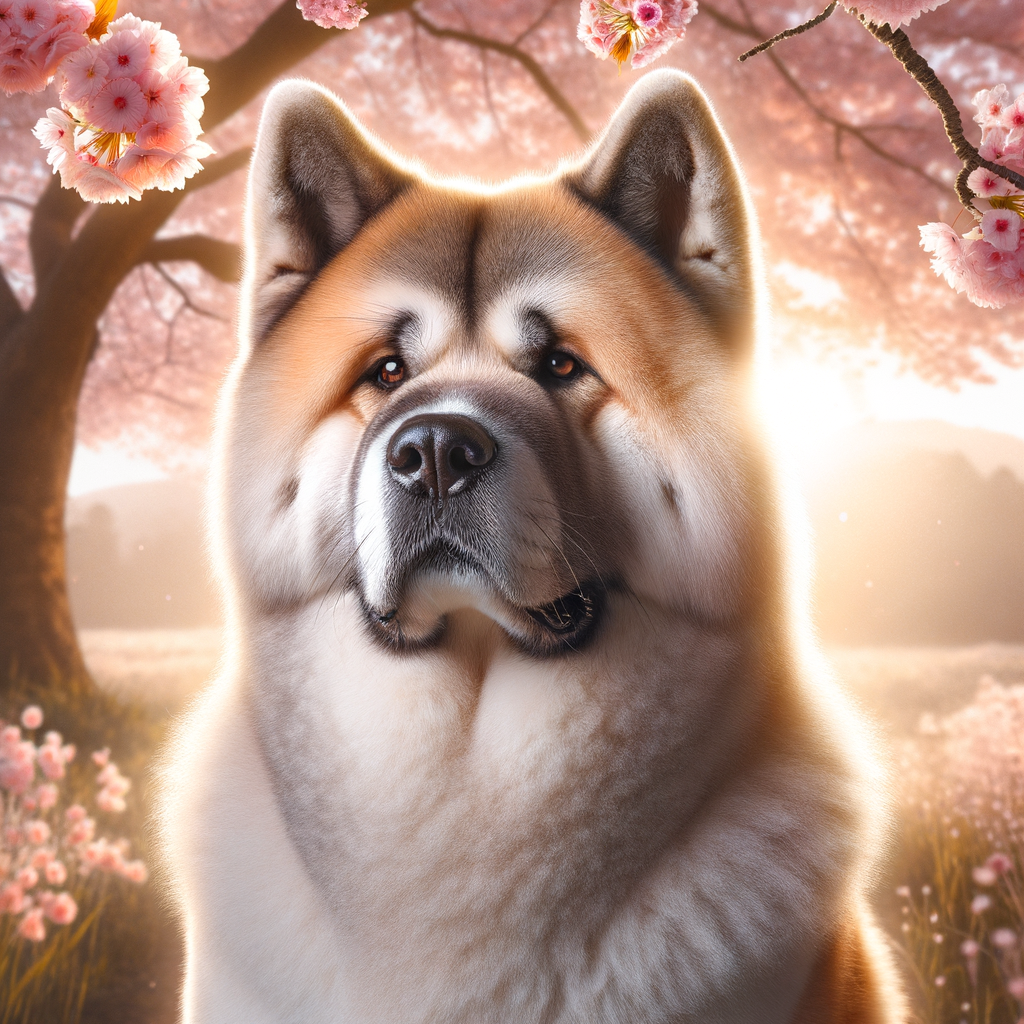Understanding the Importance of Ancient Dog Breeds
As a holistic veterinarian, I have a deep admiration for all dog breeds. But hold a special degree of awe for ancient dog breeds. These time-honored canine lineages aren’t just a living link to our past, but they’re also a testament to the enduring bond between humans and dogs that transcends thousands of years.

These breeds have evolved alongside us, adapting to our ways of life and contributing in various capacities, from herding livestock to guarding homesteads. Their genetic diversity is crucial in maintaining the overall health of the canine species. Remember, preserving these ancient lineages isn’t just about nostalgia; it’s about protecting the genetic health of future canine generations.
The Evolution of Ancient Dog Breeds Over Time
The journey of ancient dog breeds is fascinating, to say the least. They have weathered the test of time, braving the challenges nature has thrown at them. With their resilience and adaptability, they’ve survived, evolving from the primitive dog breeds wandering alongside our ancestors to the well-loved pets of today.
This evolution wasn’t merely physical – size, coat type, and color – but also behavioural. Skills like hunting, herding, or guarding have been honed over centuries, ingrained deep into their genetic makeup. These breeds carry the wisdom of ages in their genes, and it’s fascinating to see these instinctual behaviors surface even today.
Dive into this remarkable world of ancient dog breeds with me. Together, we’ll explore their history, characteristics, and roles they’ve played through the ages. We’ll also delve into their unique needs, the importance of their preservation, and how they’ve influenced the modern breeds we adore today. So join me on this journey, as we celebrate these venerable canine companions and their enduring legacy.
The Characteristics of Ancient Dog Breeds
Dive into the fascinating world of ancient dog breeds, and uncover the distinct traits that have allowed them to survive through millennia, shaping not only their history but also ours. These age-old breeds are relics from the past, their unique characteristics offering an intriguing insight into our shared history with these incredible animals.
Physical Traits of Ancient Dog Breeds
Every ancient dog breed carries a unique set of physical traits, like a living blueprint etched across generations. Many of these breeds retain physical characteristics that underscore their original roles.
For instance, the Siberian Husky, a breed that traces back more than a thousand years, possesses a thick double-coat to withstand harsh climates, and blue or multicolored eyes, traits that echo its Arctic origins. Similarly, the Basenji, hailing from central Africa and known as one of the world’s oldest dog breeds, has tightly curled tails and pricked ears, features that facilitated heat loss in its hot native environment.
On the larger end of the spectrum, the Tibetan Mastiff, indigenous to the harsh, high-altitude regions of the Himalayas, carries a large, robust build perfect for its historical role as a guard dog for livestock against wolves and leopards.
Behavioral Traits of Ancient Dog Breeds
Physical characteristics are just the tip of the iceberg. The ancient dog breeds not only possess distinctive physical traits but also remarkable behavioral attributes that have been honed over centuries.
Let’s take the Saluki, one of the oldest known breeds of domesticated dogs. Salukis were bred for hunting and have retained their exceptional sight, speed, and endurance. Their aloof, independent nature is part of their charm, reflecting their historic role as lone hunters.
The Akita, another ancient breed from Japan known for its loyalty, offers a different set of behaviors. Akitas are known to be quiet, dignified, and incredibly loyal to their families. This breed was used for hunting, guarding, and even pulling sleds, and these roles have informed their behavior over time.
The grey-eyed Alaskan Malamute, a breed as old as the Inuit tribes of Alaska, is characterized by its remarkable strength, endurance, and friendly disposition. Historically used for pulling heavy sleds across long distances in severe weather conditions, their sociable and playful nature is surprising yet delightful.
To fully appreciate these ancient dog breeds, one must delve beyond their appearance to understand their unique behavioral traits. By doing so, we not only appreciate these breeds as remarkable survivors but also as profound symbols of our shared history with dogs. Their physical and behavioral traits are like living documents, etching the story of human evolution, survival, and companionship with these incredible animals.
Understanding these remarkable animals in depth allows us to provide them the care they deserve while honoring their impressive lineage and historical significance. So, the next time you look into the eyes of an ancient dog breed, remember, you’re not just looking at a pet; you’re gazing into a thousand years of history.

Ancient Dog Breeds in Ancient Civilizations
Dogs have always been man’s best friend. Their role in human history is significant, with various ancient dog breeds playing integral parts in the development of certain civilizations.
The Saluki, considered one of the world’s oldest dog breeds, was a treasured hunting companion in ancient Egypt. Regarded as a gift from the gods, these dogs were often mummified and buried with their owners. Depictions of Salukis have been found in tombs and on papyrus scrolls, proving their significance in this civilization.
Similarly, in ancient Rome, the Molossus, an ancestor of the modern Mastiff, was renowned for its strength and fearlessness. Used in warfare, hunting, and for protection, these dogs were a valuable asset to the Romans.
The Aztecs of Central America revered the Xoloitzcuintli, or Mexican Hairless Dog, which they believed safeguarded the home from evil spirits and intruders. This breed was also thought to guide the souls of the departed through the underworld.
Ancient Dog Breeds in Mythology and Folklore
Ancient dog breeds also hold a special place in mythology and folklore. The Norwegian Elkhound, one of the most ancient Nordic breeds, features prominently in Norse mythology. These dogs were believed to be the hunting companions of gods and were respected for their tracking skills and bravery.
The Akita, a breed that originated from Japan, is also steeped in myth. Hachiko, the most famous Akita, waited for his deceased owner at a train station every day for nine years and has since become a symbol of loyalty in Japanese culture.
In Greek mythology, Cerberus, a multi-headed dog, guards the gates of the underworld. The Molossus, the dog breed mentioned earlier, is often associated with Cerberus due to their shared traits of strength, size, and loyalty.
Finally, in Celtic folklore, the Irish Wolfhound was revered for its size and strength. They were believed to be capable of fighting off wolves and even giants. Today, they are a symbol of national pride in Ireland.
In essence, ancient dog breeds have had a profound impact on our history, whether as working dogs in ancient civilizations or as central figures in myths and legends. These breeds not only provide a rich tapestry of global canine heritage but also serve as a testament to the enduring bond between humans and dogs through the ages.
The legacy these ancient dog breeds carry is not only reflective of their remarkable physical and behavioral traits, but also indicative of their significant role in human society throughout history. The stories they tell broaden our understanding of our shared past, making them invaluable to the preservation of our diverse cultural heritage.
List of Ancient Dog Breeds
Let’s explore some of the fascinating ancient dog breeds that have stood the test of time.
Detailed Overview of Specific Ancient Dog Breeds
Basenji: Known as the “barkless dog,” this breed originated in Central Africa. They have a unique, yodel-like sound, known as a “barroo,” instead of a typical canine bark. Basenjis are small, elegant dogs known for their intelligence and independence.
Saluki: Salukis are one of the oldest known breeds of domesticated dogs. They were once considered a royal dog of Egypt, and their images have been found on Egyptian tombs dating back to 2100 B.C. Salukis are known for their speed and endurance.
Chinese Shar-Pei: This breed is famous for its wrinkles. Chinese Shar-Pei dogs were originally bred for herding, hunting, and guarding. They’re known for their loyalty and aloofness with strangers.
Alaskan Malamute: These dogs are believed to be descendants of domesticated wolf-dogs who crossed the Bering Strait with Paleolithic peoples. They are powerful, sturdy dogs traditionally used for sled pulling in the Arctic.
Akita Inu: This breed has a history that dates back to the 1600s and they were originally used for hunting large game. They’re highly respected in their native Japan and are known for their loyalty and protective nature.
Unique Traits and Characteristics of Each Breed
These ancient dog breeds each have unique traits that set them apart:
– Basenji: They have a unique propensity to clean themselves like cats and are known for their problem-solving skills.
– Saluki: They are incredibly fast runners and can reach speeds up to 42 miles per hour. Salukis are also known for their grace and regal demeanor.
– Chinese Shar-Pei: The most distinguishing feature of this breed is their deep wrinkles and blue-black tongue. The name “Shar-Pei” means “sand skin,” referring to the texture of their short, rough coat.
– Alaskan Malamute: They are extremely strong and have been used for heavy sled pulling and packing. Alaskan Malamutes have a thick double coat to protect them from the cold.
– Akita Inu: Akitas are muscular dogs with thick double coats. They are often aloof with strangers but affectionate with family members. In Japan, they are considered a symbol of good health, happiness, and long life.
Every breed on this list carries with it a rich history and unique characteristics. These ancient dog breeds offer us a glimpse into our past and remind us of the long-standing relationship between humans and dogs. As dog parents, we have much to learn and appreciate from these extraordinary breeds.

Ancient Dog Breeds: Survival and Preservation
Preserving the legacy of ancient dog breeds is a task that requires a careful understanding of their unique traits, needs, and the challenges they face. These breeds, which have survived for centuries, often face threats that could potentially lead to their extinction if not addressed properly.
Threats to Ancient Dog Breeds and Their Preservation
Ancient dog breeds face numerous threats, many of which are a result of modern societal changes. The most significant of these is the loss of their traditional roles. Many ancient breeds were developed for specific tasks such as hunting, herding, or guarding. As societies evolve and these roles become less essential, the breeds often lose their purpose, and their numbers can decline.
Other threats include irresponsible breeding practices and the introduction of new diseases. Irresponsible breeding can lead to a loss of genetic diversity, which can make the breed more susceptible to health problems. New diseases can also pose a significant threat, particularly if a breed has a limited gene pool and lacks genetic resistance.
The Role of Kennel Clubs and Breed Preservation Societies
Kennel clubs and breed preservation societies play a crucial role in preserving ancient dog breeds. These organizations work to maintain breed standards, promote responsible breeding practices, and educate the public about the unique characteristics and needs of these breeds.
For instance, kennel clubs often maintain stud books and pedigree records, which are essential for tracking a breed’s lineage and maintaining genetic diversity. They may also host dog shows and other events to showcase the breed and encourage responsible ownership.
Breed preservation societies, on the other hand, often focus on a single breed and work to promote its survival. This can involve a range of activities, from rescuing and rehoming dogs of the breed, to conducting research into the breed’s health and genetics, and even lobbying for legal protections.
Some of the steps taken by these organizations to preserve ancient dog breeds include:
– Encouraging responsible breeding: This involves ensuring that breeders adhere to ethical practices that prioritize the health and wellbeing of the dogs.
– Promoting awareness: Many organizations run campaigns to educate the public about the unique traits and history of ancient dog breeds.
– Conservation programs: Some breed preservation societies have established conservation programs to protect these breeds and their genetic diversity.
As a dog parent, supporting these organizations can be a great way to help preserve the legacy of ancient dog breeds. Whether it’s adopting a dog of an ancient breed, participating in club events, or even just learning about these amazing animals, every little bit helps to ensure that these breeds continue to thrive for generations to come.
How Ancient Dog Breeds Have Influenced Modern Breeds
Unraveling the tapestry of canine evolution, we can see that ancient dog breeds have significantly influenced the development of modern breeds. Many of the popular breeds we cherish today owe their distinct traits, temperaments, and aesthetics to their ancient predecessors.
For instance, the noble Siberian Husky traces its lineage back to the ancient Chukchi dogs of Siberia, bred for thousands of years by the Chukchi people for sledding and companionship in harsh Arctic conditions. Today, Huskies retain their ancestors’ endurance, agility, and resilience, making them ideal for modern dog sports like mushing.
Similarly, the Saluki, one of the world’s oldest dog breeds, has significantly influenced the development of several modern hound breeds. Known as the royal dog of Egypt, Salukis were favored by pharaohs for their remarkable speed and agility. These traits are evident in several modern sighthounds, including the Whippet and the Greyhound.
Moreover, the ancient Mastiff breeds, characterized by their formidable sizes and protective instincts, are the forefathers of many modern large breeds like the Saint Bernard, Boxer, and the Rottweiler.
Differences Between Ancient and Modern Dog Breeds
Despite the significant influence of ancient breeds on modern dogs, stark differences exist between the two categories. Broadly speaking, ancient breeds were developed with specific functions in mind, such as hunting, herding, guarding, or companionship. However, many modern breeds have been selectively bred more for their appearance rather than their working abilities.
Ancient dog breeds, often referred to as “primitive” breeds, typically exhibit a strong survival instinct, having been bred in harsh environments. This often translates into traits such as independence, alertness, and a propensity for roaming. Modern breeds, on the other hand, are generally more adapted to domestic life, often displaying a greater need for human companionship and less roaming tendencies.
Physically, ancient breeds often retain a more “natural” appearance. They tend to have fewer health issues related to exaggerated physical traits, such as brachycephalic syndrome in Bulldogs or hip dysplasia in certain large breeds. These health issues are more prevalent in modern breeds due to selective breeding for specific exaggerated physical characteristics.
Finally, while modern breeds encompass a vast array of sizes, shapes, and coat types due to selective breeding, ancient breeds often exhibit similar characteristics to each other. These include a spitz-like appearance, with medium build, erect ears, and a curled tail, as observed in breeds like the Akita, Shiba Inu, and Samoyed.
In the grand scheme of canine history, the legacy of ancient dog breeds is undeniably interwoven with the tapestry of modern canine diversity. Their continued preservation is vital in maintaining the rich genetic heritage they represent.

Special Care Needs of Ancient Dog Breeds
Owning an ancient dog breed is not only a privilege but also a responsibility, as these breeds often have unique care needs. These dogs, being the closest link to their wild ancestors, may require specialized care to keep them healthy and happy.
Ancient dog breeds tend to be more resilient and hardy than many modern breeds, thanks to their millennia-old gene pool. However, their robust nature doesn’t make them immune to certain health concerns. Some breeds, like the Saluki, have a predisposition to genetic conditions like heart disease. The Basenji, another ancient breed, could be prone to specific issues such as Fanconi Syndrome, a disorder affecting the kidneys.
These breeds often have a unique diet, different from that of modern dog breeds. Their digestive system is more suited to a protein-rich diet. This implies that they may not do well with diets high in grains or filler ingredients found in many commercial dog foods.
Ancient dog breeds usually have a thick double coat that served as protection against harsh weather conditions. Regular grooming and brushing is essential to prevent matting and maintain skin health.
Training and Socialization of Ancient Dog Breeds
Training and socialization for ancient dog breeds can be a bit different from other dogs. These breeds are known for their high intelligence and independence, often making them more challenging to train.
Positive reinforcement methods work best with these breeds. They respond well to rewards-based training where good behavior is encouraged with treats or praise. Remember that these breeds can be sensitive, so harsh training methods are a no-go.
Socialization is crucial for ancient dog breeds. They have a strong prey drive and may not get along with other smaller pets in a household if not properly socialized. Introducing them to different environments, people, and animals at a young age can help them become well-adjusted adults.
It should be noted that these breeds, due to their primitive nature, may have a strong desire for independence and might be more aloof than other dog breeds. This doesn’t mean they don’t love or trust you. They just express it differently.
Ancient dog breeds are a precious link to our past, and caring for them is a unique experience. Understanding and catering to their specific needs can help these time-honored canine lineages thrive in the modern world. With the right care, these breeds will continue to be a testament to the enduring bond between humans and dogs.
The Future of Ancient Dog Breeds
As we continue to appreciate the diverse world of dogs, the understanding and care for ancient dog breeds also persist. The future of these historical dog breeds is indeed a subject of interest, particularly when it comes to their role in future breeding programs and the ongoing importance of their preservation.
Role of Ancient Dog Breeds in Future Breeding Programs
The ancient dog breeds serve as a crucial genetic foundation for numerous modern breeds. Their significant involvement in future breeding programs continues to provide an array of benefits. For instance, these breeds are called upon to strengthen the gene pool of modern breeds plagued by health issues due to inbreeding or genetic bottlenecking. Breeds like the robust Saluki or the resilient Basenji offer genetic diversity that can help promote longevity and vitality in new breeds.
Moreover, the characteristics of ancient breeds – their endurance, intelligence, and often unique physical features – are valued for the development of modern breeds. Breeding programs often aim to create dogs that combine the best traits of the ancient and modern dogs, whether it’s the Siberian Husky’s endurance or the Pekingese’s loyalty.
Continued Importance of Preserving Ancient Dog Breeds
Moving forward, the importance of preserving these ancient dog breeds cannot be overstated. Each breed is a living link to our past – a testament to the profound bond between humans and dogs that spans thousands of years. Preservation of these breeds allows us to maintain this connection and learn more about our shared history with these remarkable animals.
Furthermore, maintaining these breeds also means preserving the remarkable diversity in the dog world. Each breed brings unique traits, skills, and aesthetics. The Akita’s courage, the Lhasa Apso’s sharp wit, or the Afghan Hound’s striking elegance – each individual breed adds to the rich tapestry that makes up the canine species.
Preservation efforts also play a crucial role in maintaining healthy dog populations. This is achieved through responsible breeding practices that prioritize genetic health over aesthetics, ensuring that our beloved companions continue to thrive for generations to come.
As dog enthusiasts and guardians, we play a significant role in this preservation. Through our support, we can assist organizations and breeders in maintaining these incredible breeds. This includes adopting and caring for these breeds, promoting responsible breeding, and advocating for the protection of breeds facing extinction.
As we look towards the future of ancient dog breeds, it is clear that their journey is far from over. As they have done for thousands of years, these breeds will continue to evolve with us, forming an intrinsic part of our lives and societies. From aiding in the development of new breeds to serving as treasured companions, the legacy of ancient dog breeds remains undimmed. So, let’s cherish these time-honored canine lineages and continue to celebrate the rich, diverse world of dogs that we are fortunate to share our lives with.
Frequently Asked Questions
Q1: What are some examples of ancient dog breeds?
A1: Some examples of ancient dog breeds include the Basenji, Saluki, Akita Inu, and the Tibetan Mastiff. These breeds have a long history and have been around for thousands of years.
Q2: How are ancient dog breeds different from modern breeds?
A2: Ancient dog breeds have a longer lineage and are often closer to the original wolf ancestors in terms of genetics and behavior. They are usually more robust and have fewer health issues compared to some modern breeds.
Q3: What is the oldest known dog breed?
A3: The Basenji is often considered the oldest known dog breed. They are believed to have originated in central Africa and have been around for over 6,000 years.
Q4: Are ancient dog breeds suitable for first-time dog owners?
A4: It depends on the breed and the individual dog. Some ancient breeds can be quite independent and may require an experienced owner, while others are more adaptable and can do well with first-time owners. It’s always important to research the breed and consult with breeders or rescue organizations to find the best fit for your lifestyle.
Q5: How can I identify an ancient dog breed?
A5: Identifying an ancient dog breed can be challenging without genetic testing. However, certain physical characteristics, behaviors, and historical records can provide clues. Consulting with a knowledgeable breeder or a canine geneticist can also be helpful.
Dr. Candy, a holistic veterinarian and certified raw dog food nutrition specialist, graduated from Oklahoma State University in 2009 with a DVM and has since specialized in companion animal nutrition, advocating for species-specific diets. With a background in wildlife rehabilitation and oil spill response, she combines holistic health and conventional medicine in her unique approach to treating chronic diseases, allergies, and autoimmune conditions in pets. As the owner of a veterinary practice in Colorado and an author, Dr. Candy is dedicated to educating pet parents and improving the health and happiness of animals.




